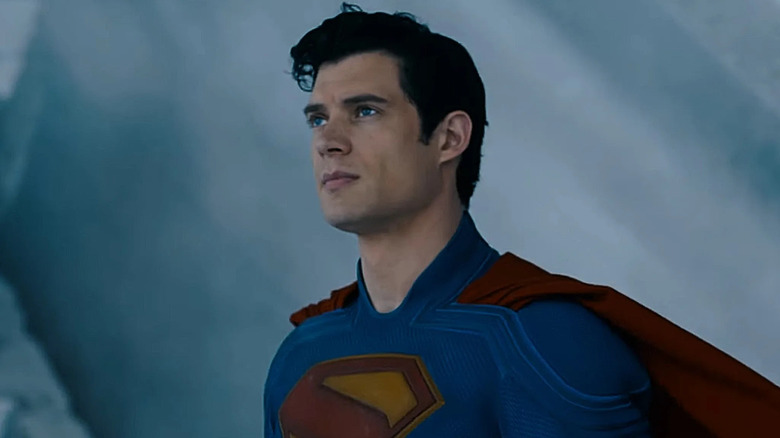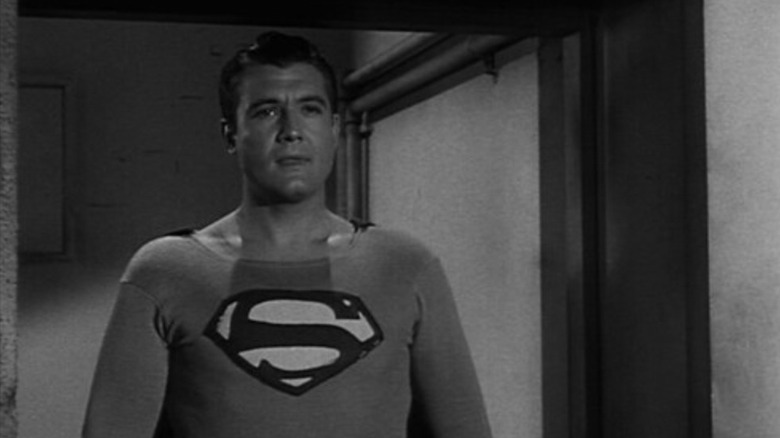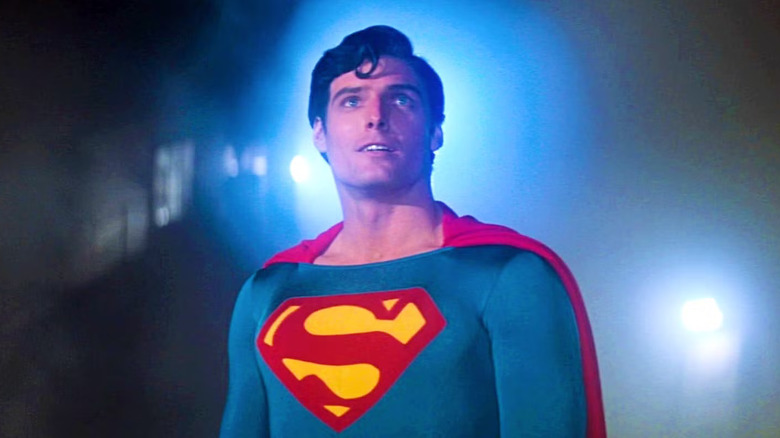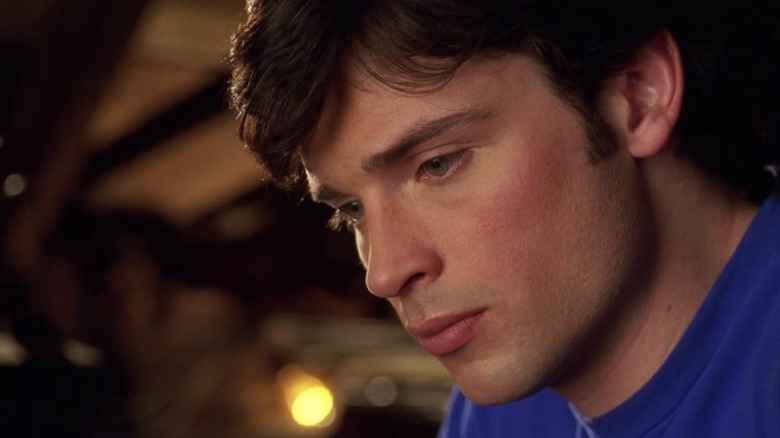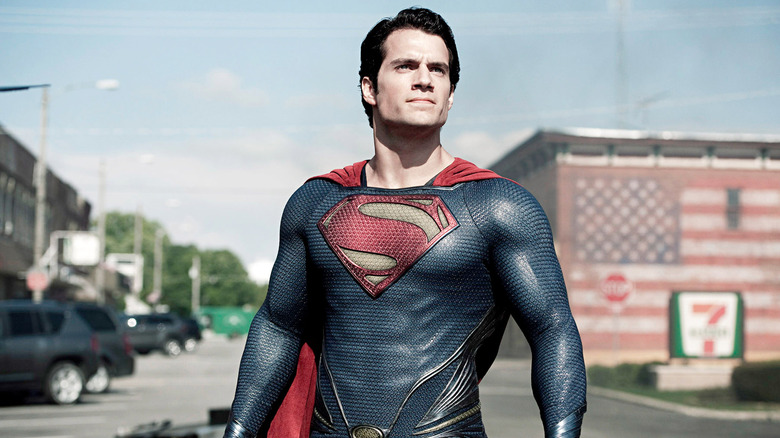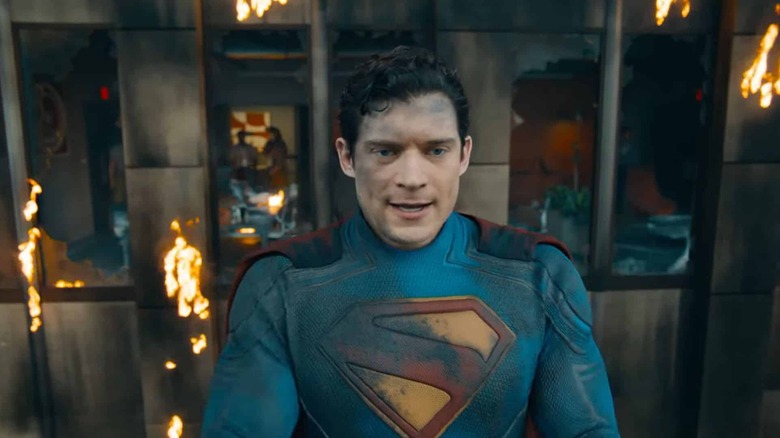How James Gunn's Superman Differs From Past Versions
This article contains spoilers for "Superman."
Superman, aka Kal-El of Krypton, aka Clark Kent of Metropolis and Smallville, Kansas, has existed as a pop culture figure for 87 years. His image, name, and origin story have become so ingrained in pop culture that he's achieved iconic status. His costume's "S" shield logo is instantly recognizable around the world, and while the character has enjoyed a variety of super powers throughout his long and complex history in the pages of comic books and on the big and small screens, everyone knows that Superman can fly and he stands for truth, justice, and the American way. Perhaps not necessarily the American way as it is, but the ideals that the country is supposed to represent.
While there are constants in his character ever since his creation by Jerry Siegel and Joe Shuster in 1938, there have been many more differences, as seen in the numerous variations of the superhero over time. This is a natural phenomenon that occurs with any long-running character who becomes interpreted by a variety of different artists. After all, no two Sherlock Holmeses or Doctor Whos are exactly alike. Yet fans can't help themselves when discussing the merits of Superman, believing that some sort of consensus or definitive take on the character exists. Not only does a definitive take not exist, it can't exist, given how much variation there is between any two depictions of the character, let alone all of them.
That's why it's more productive to highlight the differences along with the similarities between each version of Superman, as such comparison allows for each individual to build their own definitive (or at least ideal) version of Superman in their own mind. Now, writer/director James Gunn debuts his take on the character in a movie simply titled "Superman," and there's no doubt that the Superman in this movie recalls many of the prior versions of the hero. Yet there's enough that's different about the way Gunn writes him and the way actor David Corenswet plays him to make this Superman distinct. Here's a brief rundown of how 2025's Superman differs from his past incarnations.
Gunn's Superman is more nuanced than the hero of the '40s and '50s
Superman's first appearance that involved an actor's portrayal was in the 1940 radio series "The Adventures of Superman," voiced by Bud Collyer, who reprised his role for the Fleischer Studios-produced "Superman" animated shorts that began screening in 1941, and stayed on as the Man of Steel when Paramount Pictures handed the reins over to Famous Studios in 1942. Given radio's obvious lack of a visual aspect, it was Collyer who established the idea that Clark Kent should sound and act differently from Superman, not just to keep his identity a secret from Lois Lane and his fellow citizens, but to indicate to the listener which version of the character was speaking when.
When Superman finally made his first appearance in live-action, he was portrayed by Kirk Alyn, beginning his tenure in the 1948 "Superman" serial and returning for the "Atom Man vs. Superman" serial in 1950. In 1951, George Reeves took over the role for the feature "Superman and the Mole-Men," which acted as a backdoor pilot for the "Adventures of Superman" TV series, which began airing the following year. This first trio of Supermen portrayed the character as the embodiment of a heroic, American ideal. Their Superman was a man who exuded morality as much as strength, and could always be counted on to say and do the right thing.
The Gunn/Corenswet version of Superman retains some of these qualities. Certainly, Corenswet's demeanor as Superman is polite and humble, almost to the point of anachronism. To put his attitude in the modern parlance, he's a "golden retriever" type of man. That said, Corenswet's Superman is far more conflicted and doubtful about himself, his actions, and his overall purpose on Earth than the original three Supermen. The trio provided a stalwart hero for a time when America played the hero itself, busting up crime rings and taking down fascism wherever they cropped up. Corenswet's Superman, like so many modern adult Americans, has to wrestle with his heritage and the thorny politics of any given issue to try and be a role model to the people he feels obligated to help.
The James Gunn Superman pays homage to Richard Donner's, but remains unique
While the vintage "Superman" serials and TV series are obliquely referenced in Gunn's "Superman," the movie pays direct and frequent homage to what is often considered the bellwether of all "Superman" films and shows: Richard Donner's 1978 "Superman." While the initial serials and films adapted from comic books were treated with an even-keeled pulp fiction approach, the ensuing popularity of the "Superman" series on television with children (and especially the deliberately parodic 1966 "Batman" TV series) had turned superheroes into something blatantly unserious. 1978's "Superman" shifted that paradigm as the film treats the title character as nothing short of reverently mythic.
Actor Christopher Reeve defined Superman for a whole new generation, and his portrayal remained the gold standard for decades. Picking up on the differentiation established by Collyer, Reeve made his Superman even more distinctive from his Clark Kent, giving the former a movie star swagger and the latter a bumbling screwball nature worthy of Cary Grant. Donner's insistence on verisimilitude gave the film a tone that took Superman's abilities at face value, and John Williams' superlative score embodied everything about the character sonically and emotionally. That score and its main theme have become so entwined with Superman that Gunn's "Superman" makes use of it, albeit in a re-orchestrated form by composers John Murphy and David Fleming. The title credits of Gunn's film also deliberately homage that of Donner's, making each movie aurally and visually echo each other.
Gunn's movie is not slavishly devoted to Donner's like Bryan Singer's "Superman Returns" is. Corenswet distinguishes both his Superman and his Clark Kent from Reeve, making Kent in public at the Daily Planet a bit cocky and arrogant, while Kent in private is closer to Superman's "golden retriever" Everyman. Where Donner's Superman existed in a world where he's the only hero around, Gunn's Supes is merely one part of a larger DC universe, where other heroes like The Justice Gang are seeking to solve metahuman issues and crises alongside or even in competition with Kal-El. The Lex Luthor of Donner's film (played by Gene Hackman) is a lovable scoundrel, while Gunn's Lex (Nicholas Hoult) is an egotistical sociopath. The most notable difference between Donner and Gunn's films is a thematic one: Donner presents Superman as a mythic, pseudo-religious figure, someone who has to be more human than human. Gunn, meanwhile, constantly draws attention to Superman's humanity, especially in contrast to his problematic Kryptonian heritage.
Gunn's Superman cherry-picks elements of the TV Superman
That troubled inheritance is a plot point which acts as a major revelation in "Superman," yet it's not going to come as too large a surprise to any fan of the TV series "Smallville." Throughout Superman's history, the character has been subject to numerous divergent interpretations. Arguably, the first major deviation in the depiction of Superman in live action came with the TV series "Superboy," produced in 1988 by Ilya and Alexander Salkind, who helped get the Reeve "Superman" franchise off the ground. With Superboy played by John Haymes Newton in the first season and Gerard Christopher in the remaining three, the series attempted to apply some of the special effects techniques from the Reeve films with a "criminal of the week" storyline similar to other popular shows of the period like "The A-Team" and "Knight Rider." Although the show featuring a teen Clark lent itself to some soap opera trappings, "Superboy" ended up going in a more mature direction, especially as Tim Burton's "Batman" film exploded in popularity around the show's third season.
A "Superman" show with soapier elements was just around the corner, however, as "Lois & Clark: The New Adventures of Superman" premiered in 1993. Starring Teri Hatcher and Dean Cain as Lois and Superman, it took its cues from shows like "Moonlighting," focusing more on the title couple's burgeoning romance rather than intergalactic threats. This approach was echoed in the 2021 series "Superman & Lois," starring Tyler Hoechlin and Elizabeth Tulloch, and featured an already married Lois and Clark settling in Smallville, dealing with family drama along with superheroics, and allowing the characters to grow way beyond their origins.
There are aspects of these shows in Gunn's "Superman," particularly in the way Clark's relationship with Lois (Rachel Brosnahan) — which is already in progress when the film begins — is handled. Yet while there's a bit of romantic comedy in it, there's more romantic angst, which ties "Superman" more to "Smallville," the 2001 series starring Tom Welling. In that show, the teenage Clark dealt equally with sci-fi threats and raging hormones, a conflict exacerbated by the revelation that his father may have sent him to Earth to rule humanity. This development's impact was lessened after it was stated how this AI version of Jor-El was misrepresenting Kal-El's real father, yet it clearly planted a seed in Gunn's mind.
His film features a final message recorded by Jor-El (Bradley Cooper) and Lara (Angela Sarafyan) that, when translated by Lex, explicitly states that Kal-El's parents sent him to Earth to conquer its people. It's one of the boldest choices in Gunn's film and has its origins in the character's history.
The action in Gunn's Superman recalls aspects of the animated Superman
In addition to the shocking revelation about Kal-El's parents and the film's commitment to that development, another aspect of James Gunn's "Superman" that feels new to the character's depiction on screen is in its action sequences. The live-action series of the '40s and '50s made do with depicting Superman's various abilities through some combination of animation, cables and wires, and in one case, a springboard. Donner's film was sold with the tagline "You will believe a man can fly," and in addition to blue screen mattes (and more cables and wires), the film made use of a then state-of-the-art camera system which allowed Christopher Reeve to be suspended in front of a front projection screen while the camera zoomed in, which made the projected background appear to recede. Further "Superman" sequels and series adopted some version of this technique until the advent of CGI. "Superman Returns" utilized computer graphics to bring Brandon Routh's throwback take on the character into a modern aesthetic.
Yet director Zach Snyder's films involving Superman, the most recent ones before Gunn's, took a gritty, violent, and destructive approach to Superman's powers. As such, those films' action sequences are less reminiscent of prior "Superman" live-action and feel closer to something like Michael Bay's "Transformers" series, where the characters are so powerful that they leave a permanent mark wherever they go and do battle. Although Gunn's "Superman" doesn't shy away from the character's strength nor the collateral damage caused by his battles with giant creatures and robots, the film's approach to Superman's abilities and the action feels much closer to the animated adventures of Superman. Not just the Fleischer and Famous Studios versions, but the DC Universe animated movies and the various animated series as well, including the anime-inspired "My Adventures with Superman." Gunn makes the action in "Superman" a combination of impactful, visually inventive, colorful, and with a bit of a zany edge to it, allowing it to feel very comic-book inspired. It's a technique that very much recalls Gunn's prior superhero fare, such as the "Guardians of the Galaxy" trilogy and "The Suicide Squad."
Gunn's Superman is a deliberate pivot away from Henry Cavill and Zach Snyder's take
Most reboots of a character or franchise's continuity come about as a direct or implicit reaction to the reception of the last iteration or sequel. 2005's "Batman Begins" was 180 degrees away from 1997's "Batman & Robin," for example. In this vein, Gunn's "Superman" appears to be a pivot away from the DC Extended Universe take on the character, which was primarily conceived by director Zach Snyder and star Henry Cavill. Those films — "Man of Steel," "Batman v Superman: Dawn of Justice," and "Justice League" (both the Joss Whedon rework and Snyder's director's cut) similarly treat Superman to how Christopher Nolan approached Batman, which was to try and make a version of the character who was even closer to gritty reality than mere verisimilitude. In addition to the aforementioned action sequences focusing less on Superman's incredible abilities and more on their uncomfortable aftermath, the films presented Kal-El/Clark as a person who was genuinely torn between his alien birthright and his human upbringing. This Superman didn't need to discover whether his parents sent him to Earth to rule humanity or not — the question was on his mind already, and his ambivalent feelings toward the human race made him more of a mythic, godlike figure who could either be a savior or a conqueror.
While this take on the character is undoubtedly intriguing and certainly brought a unique perspective to how he's traditionally portrayed, it ultimately grated with both the larger DC Extended Universe that those films were trying to establish as well as with fans who felt that too much of the core of the character was lost. The reaction, in other words, was decidedly mixed. This is why Gunn's "Superman," despite its acknowledgment of much of the character's heritage, isn't really attempting to carry over any of this approach. That's not to indicate Gunn or any of his collaborators expressly dislikes Snyder's take, just that Gunn is using the opportunity to give the character and a larger DC Universe a fresh start. In this movie, while Superman is indeed conflicted and even indignant about how some factions of society treat him, it's clear that the man is a selfless hero who wants to help as much as he can.
James Gunn's Superman is proof that the character can be both personal and traditional
As you can see, there's a metric ton of Superman content to go around, and this is only skimming the surface. In addition to the movies and TV shows, there are, of course, nearly a century's worth of comic books, several novels, video games, and so on. Although some famous characters and franchises've been around long enough to become iconic, but have also enjoyed a large degree of creative continuity — Indiana Jones, for example — there are others like Superman, where the character has been interpreted in so many unique ways despite having a core tone. In this current age of fandoms that frequently demand fidelity to source material, it's important to remember that there are ways of keeping a property faithful without being slavish or lazy.
James Gunn's "Superman" is a case in point, as it's a movie that is as personal as it is traditional. One can see Gunn's auteurism in the film's humor, visual aesthetic, and tone, yet there is still so much of Superman's history, both vintage and current, throughout. In this way, "Superman" is an ideal adaptation. The film and Corenswet's performance will carve their own niche in the character's legacy, yet there is no doubt that this is a movie with and about the Man of Steel. Hopefully, this sweet spot that Gunn and his cast and crew have hit with the movie will allow for further adventures with this Superman to follow, and will provide a similar template for future DC Studios films. Whatever happens, one thing is for certain: Superman is here to stay, and all we need to do to see him is look up...at the screen.
